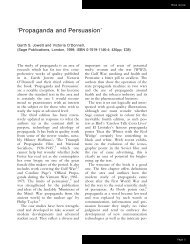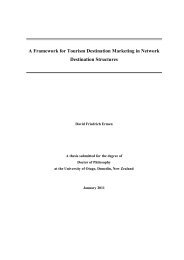Who sets the agenda? - Dr Phil Harris
Who sets the agenda? - Dr Phil Harris
Who sets the agenda? - Dr Phil Harris
You also want an ePaper? Increase the reach of your titles
YUMPU automatically turns print PDFs into web optimized ePapers that Google loves.
European<br />
Journal of<br />
Marketing<br />
35,9/10<br />
1118<br />
<strong>Harris</strong> et al. (1999) in respect of <strong>the</strong> 1997 UK General Election. The implications<br />
of this for political marketing and political campaign management are<br />
discussed.<br />
Agenda-setting<br />
Lippmann (1922) argued that <strong>the</strong> mass media are <strong>the</strong> link between world events<br />
and <strong>the</strong> pictures of <strong>the</strong>se events in our minds. Without using <strong>the</strong> modern term,<br />
he is clearly referring to what we have come to call public <strong>agenda</strong>-setting. In a<br />
similar vein, Cohen (1963) observed that <strong>the</strong> press ``may not be successful much<br />
of <strong>the</strong> time in telling people what to think, but it is stunningly successful in<br />
telling its readers what to think about’’.<br />
News media appear to determine to a considerable degree <strong>the</strong> significant<br />
issues during a political campaign (McCombs and Shaw, 1977). Media coverage<br />
structures voters’ perceptions of political issues and thus affects <strong>the</strong> ground on<br />
which campaigns are conducted. This process is commonly described as<br />
``<strong>agenda</strong>-setting’’. The term was first used formally in a study of <strong>the</strong> 1968 US<br />
presidential elections conducted by McCombs and Shaw (1972). They<br />
concluded that <strong>the</strong> media appeared to have had a significant influence on<br />
voters’ judgements of which <strong>the</strong> major issues of <strong>the</strong> campaign were and that<br />
<strong>the</strong>re was a strong relationship between <strong>the</strong> emphasis given by <strong>the</strong> media to<br />
different campaign issues and <strong>the</strong> salience which voters applied to <strong>the</strong>m.<br />
Early research defined <strong>agenda</strong>-setting in terms of <strong>the</strong> influence of <strong>the</strong> media<br />
<strong>agenda</strong> on <strong>the</strong> public one. However, <strong>the</strong> process by which issues emerge seems<br />
to be both iterative and interactive and is by no means always initiated by <strong>the</strong><br />
media. MacKuen and Coombs (1981) were <strong>the</strong> first to find evidence (although<br />
more suggestive than conclusive) that <strong>the</strong> press was ``<strong>the</strong> primary causal agent’’<br />
(p. 23) while <strong>the</strong>re was some minor feedback from <strong>the</strong> public to <strong>the</strong> press. Their<br />
conclusion that <strong>the</strong> influence of newspapers was more persistent than that of<br />
television is supported by work of Benton and Frazier (1976), Clarke and Fredin<br />
(1978), Asp (1983) and Allen and Izcaray (1988). A systematic definition of<br />
<strong>agenda</strong>-setting as a process, in which <strong>the</strong> media, public and political <strong>agenda</strong>s<br />
interact with one ano<strong>the</strong>r and with <strong>the</strong>ir mutual external environment, was<br />
proposed by Manheim and Albritton (1984) and elaborated by Manheim (1987).<br />
Each <strong>agenda</strong> has its own internal dynamics and each one is linked to <strong>the</strong> o<strong>the</strong>rs<br />
by informational, behavioural and institutional links and could be represented<br />
in diagrammatic form (Figure 1) (Rogers and Dearing, 1988).<br />
Agenda-setting and campaign strategy<br />
Becker (1977), after studying <strong>the</strong> 1972 US Presidential campaign, concluded<br />
that each party strategist tried to shift <strong>the</strong> attention of <strong>the</strong> campaign to <strong>the</strong><br />
issues which were most favourable to his candidate. Campbell et al. (1966)<br />
argued that parties should try to increase <strong>the</strong> salience of advantageous<br />
``valence’’ issues (those propositions or beliefs which are positively or<br />
negatively valued by all voters) (see also Bowers, 1977; Brosius and<br />
Kepplinger, 1992).




